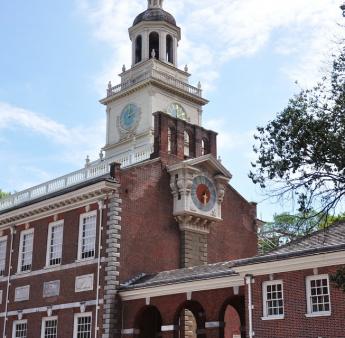
Tourist Trips:
Philadelphia and the Quaker Colonies
The states of Pennsylvania, Delaware, and New Jersey all belonged to William Penn the Quaker in one way or another. New Jersey was first, Delaware the last. Penn was the largest private landholder in American history.
A million college students and visitors annually take up residence in Philadelphia, tend to business, then gone home. They overhear scraps of history and unfamiliar names, stroll past curious buildings of whose history they knew very little. This website is for their recollections, recognizing how ex-residents often retain curiosity about these Quaker Colonies, even from a distance. At the moment, Philadelphia is a wonderful place to retire, unless you insist on having it warm in the winter.
Future visitors need a weekend guide to the funny city where they find themselves; their affection for the town may be more enduring than they expect. It's also gratifying to sense possessive local patriotism by working class Philadelphians, the people who talk about "Philly" instead of "fa-Delf-ya" but are no less owners of the place. Because of shyness, they seem to prefer to hear history from a single voice, even though multi-voice encyclopedias often contain more precision.
We begin with a five-day study tour. There's first a one-day walking tour of the center city district, which owns America's most historic square mile. It's helpful that William Penn laid out the streets with a compass, numbered streets North-South, streets named after trees East-West. Next, one-day driving tours both to the North where Washington and Howe did battle, and to the Welsh Barony along the Main Line, going West. Finally, a two-day tour down the New Jersey side of Delaware Bay, across the Bay by ferry, home along the state of Delaware side. That's the four points of the compass, with a city in the center.
But by no means the full extent of what's fascinating. If there's time, take a Sunday excursion along the upper Delaware on the Riverline railroad. Or, a trip up the King's Highway and back down the Jersey coastline of beaches. A ride on the Paoli Local, or the Chestnut Hill Local. House tours, garden tours, architectural tours, and some descriptive visits inside the big law firms, the big hospitals, and the many volunteer organizations.
We firmly believe in our Trinity: the Brotherhood of Man, the Fatherhood of God, and, the Neighborhood of Philadelphia. We hope you will, too.
- Tourist Walk in Olde Philadelphia Colonial Philadelphia can be seen in a hard day's walk, if you stick to the center of town.
- Historical Preservation The 20% federal tax credit for historic preservation is said to have been the special pet of Senator Lugar of Indiana. Much of the recent transformation of Philadelphia's downtown is attributed to this incentive.
- Colonial Philadelphia (Pre- 1776)
 It's surprising to most Americans to learn the American Revolution was not the beginning, but almost half-way through the European settlement. And before the Revolution, there were thousands of years of settlement by non-European tribes. We know more about non-European settlers than we did fifty years ago, but records are still very poor or non-existent, and not likely to catch up very rapidly. History will begin in 1492 for a very long time. Long before that, it isn't history, it's anthropology.
It's surprising to most Americans to learn the American Revolution was not the beginning, but almost half-way through the European settlement. And before the Revolution, there were thousands of years of settlement by non-European tribes. We know more about non-European settlers than we did fifty years ago, but records are still very poor or non-existent, and not likely to catch up very rapidly. History will begin in 1492 for a very long time. Long before that, it isn't history, it's anthropology.
- Downtown
A discussion about downtown area in Philadelphia and connections from today with its historical past.

- City Hall to Chestnut Hill There are lots of ways to go from City Hall to Chestnut Hill, including the train from Suburban Station, or from 11th and Market. This tour imagines your driving your car out the Ben Franklin Parkway to Kelly Drive, and then up the Wissahickon.
- North of Market The term once referred to the Quaker district along Arch Street, and then to a larger district that had its heyday after the Civil War, industrialized, declined, and is now our worst urban problem area.
- Tourist Trips Around Philadelphia and the Quaker Colonies The states of Pennsylvania, Delaware, and southern New Jersey all belonged to William Penn the Quaker. He was the largest private landholder in American history. Using explicit directions, comprehensive touring of the Quaker Colonies takes seven full days. Local residents would need a couple dozen one-day trips to get up to speed.
- Philadelphia's River Region
A concentration of articles around the rivers and wetland in and around Philadelphia, Pennsylvania.

- Land Tour Around Delaware Bay
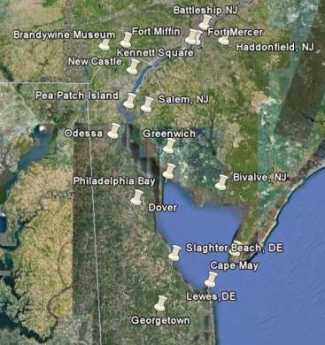 Start in Philadelphia, take two days to tour around Delaware Bay. Down the New Jersey side to Cape May, ferry over to Lewes, tour up to Dover and New Castle, visit Winterthur, Longwood Gardens, Brandywine Battlefield and art museum, then back to Philadelphia. Try it!
Start in Philadelphia, take two days to tour around Delaware Bay. Down the New Jersey side to Cape May, ferry over to Lewes, tour up to Dover and New Castle, visit Winterthur, Longwood Gardens, Brandywine Battlefield and art museum, then back to Philadelphia. Try it!
- Historical Motor Excursion North of Philadelphia The narrow waist of New Jersey was the upper border of William Penn's vast land holdings, and the outer edge of Quaker influence. In 1776-77, Lord Howe made this strip the main highway of his attempt to subjugate the Colonies.
- The Park and Beyond: East Falls, Germantown, Mt. Airy and Chestnut Hill Fairmount Park is large enough to split the City from its suburbs, and is partly a playground, partly a museum. East Falls, Germantown and Chestnut Hill are almost a separate world on the far side of the park.
- To Germantown, a Short Appreciation Seven miles from the heart of Philadelphia, Germantown was once a separate town, the cultural center of Germans in America. Revolutionary battles were fought here, it was briefly the capital of the United States, and it still has an outstanding collection of schools and colleges.
- Philadelphia's Middle Urban Ring Philadelphia grew rapidly for seventy years after the Civil War, then gradually lost population. Skyscrapers drain population upwards, suburbs beckon outwards. The result: a ring around center city, mixed prosperous and dilapidated. Future in doubt.
- The Main Line Like all cities, Philadelphia is filling in and choking up with subdivisions and development, in all directions from the center. The last place to fill up is the Welsh Barony, a tip of which can be said to extend all the way in town to the Art Museum.
- West of Broad A collection of articles about the area west of Broad Street, Philadelphia, Pennsylvania.
- Touring Philadelphia's Western Regions Philadelpia County had two hundred farms in 1950, but is now thickly settled in all directions. Western regions along the Schuylkill are still spread out somewhat; with many historic estates.
- Sights to See: The Outer Ring There are many interesting places to visit in the exurban ring beyond Philadelphia, linked to the city by history rather than commerce.
- Delaware (State of)
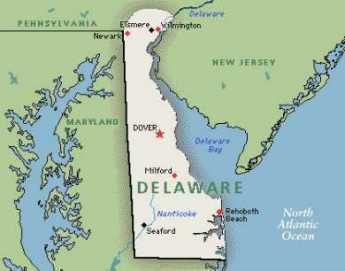 Originally the "lower counties" of Pennsylvania, and thus one of three Quaker colonies founded by William Penn, Delaware has developed its own set of traditions and history.
Originally the "lower counties" of Pennsylvania, and thus one of three Quaker colonies founded by William Penn, Delaware has developed its own set of traditions and history.
- Montgomery and Bucks Counties The Philadelphia metropolitan region has five Pennsylvania counties, four New Jersey counties, one northern county in the state of Delaware. Here are the four Pennsylvania suburban ones.
- New Jersey (State of)
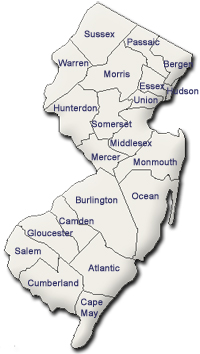 The Garden State really has two different states of mind. The motto is Liberty and Prosperity.
The Garden State really has two different states of mind. The motto is Liberty and Prosperity.
- Northern Overland Escape Path of the Philadelphia Tories 1 of 1 (16)
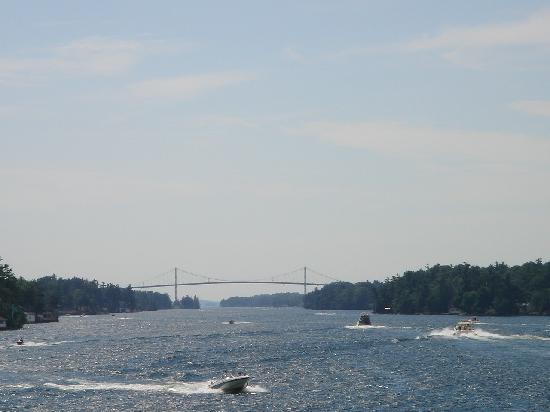 Grievances provoking the American Revolutionary War left many Philadelphians unprovoked. Loyalists often fled to Canada, especially Kingston, Ontario. Decades later the flow of dissidents reversed, Canadian anti-royalists taking refuge south of the border.
Grievances provoking the American Revolutionary War left many Philadelphians unprovoked. Loyalists often fled to Canada, especially Kingston, Ontario. Decades later the flow of dissidents reversed, Canadian anti-royalists taking refuge south of the border.
- Litchfield to Wilkes Barre, Today The journey of Connecticut's invasion path into Pennsylvania has changed little in two centuries. But some pretty important history has since taken place along that route.